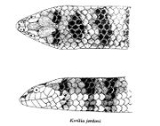
Kerilia jerdonii
Encyclopedia
Jerdon's Sea Snake is a species of sea snake.
M. A. Smith (1943) describes the species as follows:
Head short, snout declivous and much narrowed anteriorly ; e moderate ; rostral as high as broad ; prefrontals small, usually not in contact with the supralabials ; frontal much longer than broad, nearly as long as its distance from the end of the snout : 1 pre- and 1 postocular ; 6 supralabials, the last often confluent with the single anterior temporal, the 3rd and 4th touching the eye : 7-8 infralabials,the first three in contact with the genials, both pairs of which are well developed and in contact with one another.
17 scale-rows on the neck. 21 or 23, rarely 19, at mid-body, imbricate and strongly keeled ; Ventrals 225-253 for specimens from the coasts of India and Gulf of Siam ; 247-278 for 11 exampl from Cap St. Jacques and S. Annam (fide Bourret, p. 25).
Hemipenis forked near the tip ; it is spinose throughout, the spines being of moderate size, closely set and becoming slightly larger as they approach the proximal end.
Olive above, yellowish or white beneath, with black dorsal spots or rhombs which extend round the body to form complete bands in the young ; intermediate dorsal spots or bans are usually present.
Examples from the Hay of Bengal have 19 or 21 scales at mid-body and the dorsal bars number from 30-38 (typical form).
Examples from the Gulf of Siam have usually 21 or 23 scales at mid-body and the dorsal bars number from 34
(K. j. siamensis).
Total length : 1 m, tail 100 mm.
Race siamensis: Gulf of Thailand
Type locality: Madras, India
Description
- See snake scalesSnake scalesSnakes, like other reptiles, have a skin covered in scales. Snakes are entirely covered with scales or scutes of various shapes and sizes. Scales protect the body of the snake, aid it in locomotion, allow moisture to be retained within, alter the surface characteristics such as roughness to aid in...
for terms used
M. A. Smith (1943) describes the species as follows:
Head short, snout declivous and much narrowed anteriorly ; e moderate ; rostral as high as broad ; prefrontals small, usually not in contact with the supralabials ; frontal much longer than broad, nearly as long as its distance from the end of the snout : 1 pre- and 1 postocular ; 6 supralabials, the last often confluent with the single anterior temporal, the 3rd and 4th touching the eye : 7-8 infralabials,the first three in contact with the genials, both pairs of which are well developed and in contact with one another.
17 scale-rows on the neck. 21 or 23, rarely 19, at mid-body, imbricate and strongly keeled ; Ventrals 225-253 for specimens from the coasts of India and Gulf of Siam ; 247-278 for 11 exampl from Cap St. Jacques and S. Annam (fide Bourret, p. 25).
Hemipenis forked near the tip ; it is spinose throughout, the spines being of moderate size, closely set and becoming slightly larger as they approach the proximal end.
Olive above, yellowish or white beneath, with black dorsal spots or rhombs which extend round the body to form complete bands in the young ; intermediate dorsal spots or bans are usually present.
Examples from the Hay of Bengal have 19 or 21 scales at mid-body and the dorsal bars number from 30-38 (typical form).
Examples from the Gulf of Siam have usually 21 or 23 scales at mid-body and the dorsal bars number from 34
(K. j. siamensis).
Total length : 1 m, tail 100 mm.
Distribution
Indian Ocean (Sri Lanka, India, Myanmar (Burma), Mergui Archipelago), Coast of Taiwan (China), South China Sea Bay of Bengal (to Sri Lanka), Along coasts of W Malaysia to Gulf of Thailand, Gulf of Siam, Indonesia (Borneo)Race siamensis: Gulf of Thailand
Type locality: Madras, India
Other sources
- Rasmussen,A.R. & Andersen,M. 1990 The sea snake Kerilia jerdoni Gray (1849): First records from Andaman Sea, Phuket Island, Thailand, with remarks on the two subspecies. The Snake 22: 131-133

